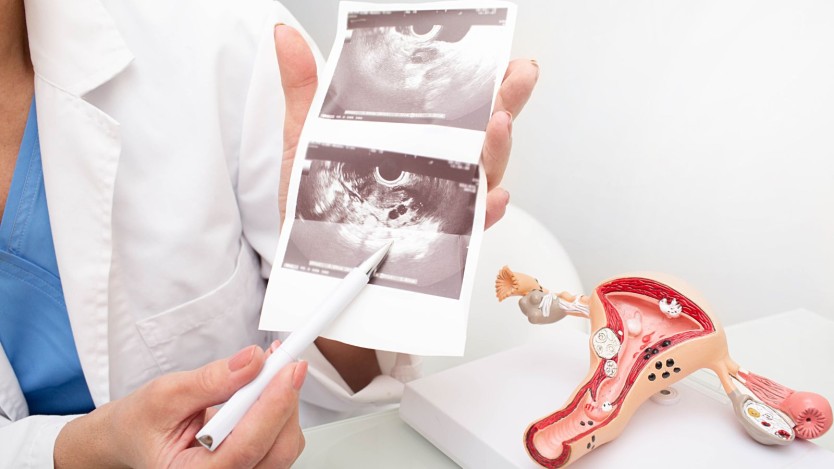Fibroids in the uterus: causes, types, symptoms and treatments

- What are fibroids in the uterus?
- What types of fibroids are there?
- What are the causes of fibroids in the womb?
- Symptoms of fibroids in the uterus
- Treatments for fibroids in the uterus
- Request free surgical assessment consultation with Operarme
What are fibroids in the uterus?
- Fibroids in the womb, also called uterus, are benign tumours that form inside the womb.
- When fibroids in the uterus cause symptoms, treatment is indicated.
- Treatment of uterine fibroids usually requires surgery.
Uterine fibroids are tumours located in the female reproductive system, specifically in the uterus. The uterus is made up of three layers: the innermost, mucous layer is the endometrium. The middle one, which is a muscular layer, is called the myometrium. The outermost is the serosa or perimetrium.
A fibroid is generated from a proliferation of the smooth muscle cells that make up the myometrium.
Depending on their location, the number of fibroids that develop and their size, they can cause a series of symptoms that can compromise the day-to-day life of a woman with this condition to a greater or lesser extent.
Below you will find all the information about uterine fibroids, from their appearance, types and symptoms to the techniques and treatments you can use to solve the problem. Don't lose any detail, being well informed will help you make the best decision.

A fibroid in the womb is the name given to masses of muscle tissue that form abnormally inside the muscular layer of the uterus and the areas near the uterus, such as the cervix, which are abnormally formed. This layer is the outermost of the two that make up the womb and is responsible for contractions during childbirth and for expelling the foetus.
These masses (or tumours) are in most cases benign tumours. When a woman presents with a sarcoma (the malignant equivalent of a myoma, known as a leiomyosarcoma), it is malignant from the start and rarely arises from the malignisation of a benign tumour (< 0.10%).
Uterine fibroids are estimated to be present in more than 50% of women, being more frequent in women aged 35-45 years.
Fibroids are the most common tumours that can develop in the female reproductive organ, affecting approximately one fifth of the female population of childbearing age. This is because their growth and development are related to female hormones, so that when women reach the menopause, they tend to reduce in size or even disappear.
Other terms by which we can refer to fibroids in the womb or uterine fibroids are leiomyoma, fibroid or uterine fibroid.
What types of fibroids are there?
Fibroids can be classified according to their location in the thickness of the female uterine wall or according to their size.
In terms of their location in the uterus, there are four types of uterine fibroids. These are:
- Intramural myomas grow in the thickness of the muscular wall of the uterus. Intramural fibroids are the most common of all, accounting for 85% of all fibroids.
- Submucosal: located under the uterine lining, in the innermost layer. Submucosal fibroids account for 5% of uterine fibroids and are the ones that present the greatest number of vaginal haemorrhages, with greater menstrual bleeding and haemorrhages outside of menstruation.
- Subserosal: present under the outer covering of the uterus. These fibroids occur in 10% of cases and can sometimes reach other organs.
- Pedunculated: these are fibroids with a pedicle or stalk, which can grow towards the inside of the uterus or towards the outside of the uterus. Pedunculated fibroids are the least frequent.
As far as size is concerned, the size of a uterine fibroid varies greatly. Fibroids can have a diameter of less than 2 centimetres, which is considered small, or, on the contrary, they can measure more than 20 centimetres, which is considered a giant fibroid. The size classification is useful when determining the surgical technique to be used to treat the lesion.
What are the causes of fibroids in the womb?
The exact causes for the development of fibroids in the womb are unknown, however, the growth of this tumour appears to be associated with female sex hormones, oestrogens and gestagens.
The development of fibroids is often primarily related to female hormones and hereditary factors.
Another possible cause of a woman being more prone to develop uterine fibroids is that genetics is also involved in the development of some types of uterine fibroids. This is known as the hereditary factor.

Another important factor is that women who have their first period at an early age are more likely to develop uterine fibroids.
It should be noted that the majority of women affected by uterine fibroids are over 30 years of age, being a tumour that affects half of all women by the age of 50, and fibroids are also more common in black women than in white women.
Are you going through the discomfort and problems caused by uterine fibroids? You can click on the image below to request a free surgical assessment consultation with our Gynaecology Specialists:

Do you need myomectomy surgery?
Request a free and immediate appointment with our specialists in Gynaecology
Symptoms of fibroids in the uterus
Fibroids in the womb do not necessarily have symptoms. If they are of a very small size, they may not even be noticeable on physical examination. When the patient presents symptoms, it is time to treat them. The symptoms associated with uterine fibroids are as follows:
Abnormal bleeding
Abnormal bleeding is one of the most common symptoms of uterine fibroid. It can occur in periods that do not correspond to the menstrual cycle, or on the contrary, it can occur during the period, causing a greater loss of blood or a longer than usual duration of bleeding, which can lead to anaemia in the patient due to the loss of blood.
Heavy bleeding is one of the main symptoms of uterine fibroids.
Pelvic pain
Pelvic pain usually accompanies bleeding and is the second most common symptom. It is caused by the bulging of the fibroids that grow from the uterus to the outside, and causes sharp, occasional pain during menstruation.
The size and number of fibroids is usually related to the intensity of pelvic pain.
This pain can be reduced by taking painkillers at the times when it is most uncomfortable. The decrease in pelvic pain depends to a large extent on the size and number of fibroids, although taking painkillers is a temporary solution; the pain may reappear in the following period, as the fibroid continues to exist.
Pelvic heaviness
If the fibroids are large and subserosal, they can cause compression of the organs near the affected area, which can lead to problems in the excretory apparatus or in the intestines. These problems are manifested by
- Urinary disturbances
- Gas
- Constipation
- Feeling of abdominal distention
The result is that the affected person experiences an uncomfortable feeling of abdominal and pelvic heaviness and localised stabbing pains. Similarly, in many cases, this heaviness combined with increased sensitivity in the area causes pain during sexual intercourse.
Infertility in women
The alteration of the uterine cavity that fibroids sometimes cause can reduce the likelihood of a woman becoming pregnant, or if she does, increase the risk of miscarriage.
The main problems that uterine fibroids can cause in relation to fertility have to do with the difficulty for spermatozoa to access the fallopian tubes or the descent of the eggs for fertilisation, with the difficulty for the egg to adhere to the walls of the uterus after fertilisation, or even the system responsible for nourishing the foetus during the days following fertilisation can be altered, preventing the foetus from developing.
As you have seen, the symptoms of the presence of uterine fibroids can be multiple and bothersome, which is why it is really important to detect them quickly and go to see a specialist, classify them and decide on the most appropriate treatment to remedy the problem.
Below we will explain the treatments that exist for the removal of uterine fibroids and what they consist of. You can also contact Operarme by calling at +34 91 141 33 56 or fill in the contact form so that our patient service department can call you and arrange a consultation with a specialist in gynaecology:

Do you need myomectomy surgery?
Request a free and immediate appointment with our specialists in Gynaecology
Treatments for fibroids in the uterus
From a medical point of view, women who do not manifest the symptoms of uterine fibroids do not need to undergo treatment. However, it is advisable to have a gynaecological follow-up of the fibroids in order to detect changes in the size of known fibroids or the appearance of new ones at an early stage.

Pharmacological treatment
If, on the other hand, you have experienced early but mild symptoms, treatment is usually with MSRP drugs (selective progesterone receptor modulators), administered orally; GnRH analogues (by injection or in extended-release, subcutaneously implanted devices).
Intrauterine devices with hormonal release in the uterine cavity or oral hormonal contraceptives (contraceptive pill) are no longer indicated, as they may worsen symptoms in some types of fibroids (especially hormone-releasing IUDs).
If anaemia is also detected, treatment should be supplemented with oral iron supplements. For pelvic pain, analgesics are most commonly prescribed.
Pharmacological treatment, as well as surgical treatment, is established taking into account several factors:
- The size of the fibroids
- the number of fibroids present in the uterus
- The location of the fibroids
- The age of the woman, her gynaecological history and whether or not she wishes to have children.
On the other hand, if the drugs do not have the expected effect, surgical treatment is the only solution that will eliminate the fibroids completely and permanently, although in some cases they may recur after surgery.
Surgical intervention is often resorted to when unsuccessful:
- Correct excessive bleeding
- Anaemia severely affects the body.
- Fibroids are excessively large
- Infertility
- Pelvic pressure and the resulting pain cannot be controlled with painkillers.
The surgical interventions with which uterine fibroids are usually treated are as follows (the choice of one technique or another will depend on the location of the fibroid, its size and number, as well as the patient's reproductive desire).

Laparoscopic myomectomy
Laparoscopic surgery is a minimally invasive procedure and is used as a substitute technique for open surgery. Access to the uterus and nearby affected areas is made through small incisions in the abdomen in order to introduce the surgical instruments necessary to perform the operation to remove the fibroids.
The main advantage of this operation is that tissue damage is greatly reduced, resulting in a much shorter postoperative period and a faster recovery.
- Anaesthesia: General
- Length of operation: 30 - 120 min
- Hospital stay: 1 day
- Recovery time: 1 - 2 weeks
Hysterectomy or complete removal of the uterus
Abdominal hysterectomy is a very common treatment to remove large or very numerous fibroids, especially in women of menopausal age or those who no longer wish to have children. It is an operation with a low complication rate.
- Anaesthesia: General
- Length of operation: 60 - 80 min
- Hospital stay: 3 days
- Recovery time: 2 weeks
Abdominal myomectomy
If, on the other hand, the patient still wishes to conceive, an abdominal myomectomy is usually chosen, which removes the large fibroids that cause the symptoms. This procedure requires hormonal treatment prior to removal in order to reduce the size of the fibroids as much as possible. The operation consists of accessing the uterus through an incision in the abdominal wall, which requires the subsequent suturing of the damaged layers in the surgical approach.
- Anaesthesia: General
- Length of operation: 45 - 120 min
- Hospital stay: 2 days
- Recovery time: 4 - 6 weeks
Robotic myomectomy, with Da Vinci Robot
Robotic myomectomy is an alternative surgery to hysterectomy that aims to remove fibroids without removing the uterus completely. This procedure is recommended for women who still wish to become pregnant, or who want to maintain the integrity of their uterus for other reasons.

In addition, robotic surgery is an advanced, high-level technology that allows complex surgical procedures to be performed through small incisions, making it the least invasive and most precise option available today.
- Anaesthesia: General
- Length of operation: 1 - 2 hours
- Hospital stay: 5 days
- Recovery time: 1 - 2 weeks
Request free surgical assessment consultation with Operarme
Throughout the article, you have been able to read all the information on the development of fibroids in the uterus and their surgical solution with the various treatments that exist.
After learning more about the disease and the techniques, it is possible that you may be interested in having a free surgical assessment consultation with the specialist, which is why Operarme makes it available to you free of charge.
Therefore, if you would like to request your free surgical assessment consultation with the specialist, you can call our patient care department on +34 91 141 33 56 or fill in our contact form.

We remind you that our company has a personalised patient care service, so if you contact us using the form, one of our advisors will contact you immediately.
In any case, they will answer any questions you may have regarding the management and services provided by Operarme in the different surgical interventions for the removal of uterine fibroids or, if you wish, they will arrange a surgical assessment consultation with the Gynaecology Specialist.
Bear in mind that this consultation is not for diagnosing the possible development of fibroids, as you should already have a clear diagnosis to determine this. In this consultation, the need for surgery in your case will be assessed, as well as your suitability to undergo any of the surgical procedures, always depending on the particularities of your case.
Below, you can click and request your consultation with the specialist:

Do you need myomectomy surgery?
Request a free and immediate appointment with our specialists in Gynaecology
Medical disclaimer: All the published content in Operarme is intended to disseminate reliable medical information to the general public, and is reviewed by healthcare professionals. In any case should this information be used to perform a diagnosis, indicate a treatment, or replace the medical assessment of a professional in a face to face consultation. Find more information in the links below:
